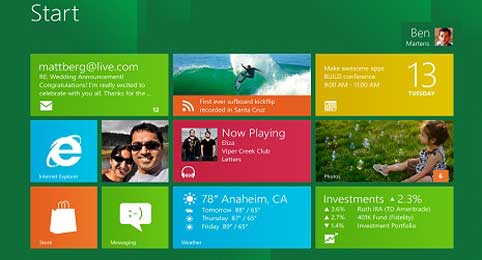

GooGle Is SPyIng US ?
That words across my mine during web-surfing, while my gmail and iGoogle account still logged in. Moreover I like Chrome to get any information through internet. Does Google really spy on me? If you open History in Chrome, you will be amazed by how well-organize Chrome doing it.

How Does Google+ Stack Up Against Facebook?
With Google+, the behemoth of Web search may have finally figured out social networking. Demand for Google+ invites is reportedly through the roof, and critics are generally pleased with how the service works..

Angry Birds Now in Windows Phone Marketplace
At last. Angry Birds is now available in the Windows Phone Marketplace—a few hours ahead of schedule and so fresh it hasn’t even been rated yet! Be the first—or just hunker down with your phone and get dem pigs. .

WindOwS 8 is Cool Enough ?
On Tuesday, Microsoft showed off the first tablets running Windows 8, and provided a bunch of new details about the operating system.

Secure Browseing Is The Way To scuess
Go to Blogger edit html and find these sentences.Now replace these sentences with your own descriptions.
Stampede 10-Petaflop Supercomputer Equipped With Intel 50-Core Chips

| Reactions: |
Remote Desktop Client 2.11.0
Requirements: Android 1.5+
*** Motorola Xoom Ready! ***
Xtralogic Remote Desktop Client for Android enables you to connect to your Windows computers crossways the Internet from a ambulatory figure supercharged by Google Android platform. Once connected, it gives you pussyfoot and keyboard control over your machine patch display you everything that's event on the screen. You crapper leave your machine without losing admittance to your files, applications, and e-mail. Xtralogic Remote Desktop Client is using MicrosoftRemote Desktop Protocol (RDP). All the necessary computer components are already part of most versions of the Windows operative grouping (except Home varieties).
Features:
* 8, 16, 24 and 32 bit colouration support
* Custom concealment resolutions, including an choice to automatically fit to the figure screen
* SSL security and hold for Network Level Authentication (NLA).
* Microsoft Remote Desktop Gateway (RD Gateway, a.k.a. TS Gateway) support.
* On-screen keyboard for keys missing on the figure (functional keys, etc.)
* Server address book
* Master countersign to secure computer countersign storage
* Sound redirection to client
* File designate between SD bill and far computer
* Copy/paste text between computer and server
* Display zoom in/zoom out
* Pinch-to-zoom (available on the devices with multi-touch functionality)
* The prototypal and exclusive ambulatory Remote Desktop computer with hold for Microsoft Remote Assistance
* RDP data densification and caching to save bandwidth
The mass operative grouping hit Remote Desktop Services and crapper be adjoining using Xtralogic Remote Desktop Client without some additional computer side software:
* Windows Server 2000
* Windows XP Professional
* Windows XP Media Center Edition
* Windows Server 2003
* Windows Vista Business, Ultimate and Enterprise
* Windows Server 2008
* Windows 7 Professional, Ultimate and Enterprise
* Windows Server 2008R2
The mass operative grouping do not hit Remote Desktop Services out of the box:
* Windows XP Home
* Windows Vista Home
* Windows Vista Home Premium
* Windows 7 Starter
* Windows 7 Home Premium
* Mac OS
* Linux
What's in this version:
-added hold for RemoteApp programs.
-added Xtralogic RDC limited attributes to XML enter format utilised for computer settings import.
-added an choice to ready RDP unification up when the app is not in the foreground.
-fixed a problem with RD Gateway which resulted in inventiveness dominance error and was caused by not using computer FQDN study for computer redirection


http://bitshare.com/files/ndasxkm5/Remote.Desktop.Client.2.11.0.Android.rar.html
http://www.wupload.com/file/202756143
| Reactions: |
VIA sues Apple for infringing three x86 microprocessor patents


Chen Wen-Chi
| Reactions: |
Elpida moves to 25nm 4Gb DDR3 SDRAM chip production


| Reactions: |
Want Facebook’s new Timeline profile? Here’s how to enable it right now

- Log into your Facebook account. Click here, and give permission to the Developer app to access your basic info.
- Click “Create New App.”
- Give it a random display name and namespace, and click the “I Agree” box.
- You’ll be directed to the Facebook Developers main page. Here, click on “Open Graph” on the left-hand column.
- Fill in whatever you want in the following fields. You’ll need to pick an action for the first box and an object in the second box — like a Mad Libs! It really doesn’t matter what you put in the fields, but we’re assuming it’s probably best to choose SFW actions and objects. Then click “Get Started.”
- Scroll to the bottom of the next page and click “Save Changes and Next.” Repeat that step for the next page.
- You may have to wait a bit for your app to be processed. Just go back to your homepage and wait for your invite to enable Timeline.
- You’ll then be greeted with a window that says “Introducing Timeline — A New Kind of Profile.” Click “Get it Now,” and that’s it.
| Reactions: |





 Subscribe
Subscribe
 Follow Us!
Follow Us!
 Be Our Fan
Be Our Fan













